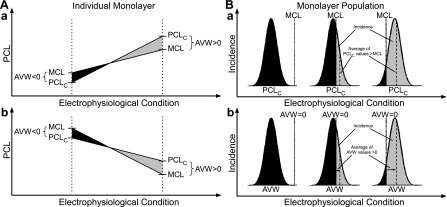Fig. 8.
General concept of AVW. A: AVW for an individual monolayer. If AVW, defined as PCLC − MCL, is >0 (shaded region), alternans occurs. If AVW is <0 (solid region), there is no alternans. Differential sensitivities of PCLC and MCL to an electrophysiological condition give different alternans responses at different PCLs. A, a: Case where both PCLC and MCL are increasing and where PCLC increases with greater sensitivity (slope). A, b: Case where both PCLC and MCL are decreasing, and where MCL decreases with greater sensitivity. Both cases result in AVW going from negative to positive. B: AVW for a monolayer population. B, a: For a Gaussian distribution of PCLC values, alternans will be induced in all monolayers that fall to the right of the MCL line (shaded region). The sensitivity of the PCLC distribution or MCL line to an electrophysiological condition can shift the proportion of monolayers in which alternans is induced. B, b: the same concept applies for the more general case where AVW has a Gaussian distribution, as a result of the difference between a Gaussian distribution for both PCLC and MCL, and where the AVW = 0 line separates regions of alternans (shaded region) and no alternans (solid region). A similar concept holds for PCLD, MCL, AVWD, and the incidence of spatially discordant alternans.

